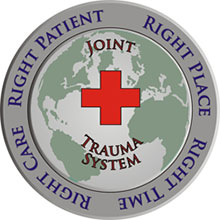Joint Trauma System (JTS)

Joint Trauma System (JTS) Institute of Surgical Research
JTAPIC Support
Joint Trauma System supports JTAPIC mission by:
- Providing Wounded in Action (WIA) injury data and coding from the Department of Defense Trauma Registry (DoDTR) to the JTAPIC program in response to Requests for Information (RFIs)
- Performing and participating in the development of JTAPIC analysis products
- Assist in the development and maintenance of analytic tools and databases as required.
- Providing subject matter expertise as required.
Mission
OPTIMIZING COMBAT CASUALTY CARE
The mission of the JTS is to improve trauma care delivery and patient outcomes across the continuum of care utilizing continuous performance improvement and evidence-based medicine driven by the concurrent collection and analysis of data maintained in the DoD Trauma Registry.
Vision
The JTS vision is to expand globally as a resource.
About
The Joint Trauma System (JTS), designated as the Department of Defense Center of Excellence for Trauma by the Office of the Assistant Secretary of Defense, provides improved trauma care across all levels of care to trauma patients, battle injury and non-battle injury. The JTS is hosted at the United States Army Institute of Surgical Research (USAISR) facilities.
JTS is dedicated to the reduction of morbidity and mortality of combat casualties at all levels of care and providing the right care to the right patient at the right place at the right time throughout the continuum of care. JTS defines Continuum of Care as an integrated system of all events, phases, levels and intensities of trauma patient care across the DoD including but not limited to prevention, point of injury, pre-hospital, patient movement, medical treatment facility acute, subacute, chronic care and life-long rehabilitation.
Similar to the civilian model established by the American College of Surgeons Committee on Trauma (ACS-COT), the mature trauma system contains all the components identified with optimal care of the patient from prevention through acute care, rehabilitation and return-to-duty.
JTS is engaged in a systematic fashion to determine the acute and long term outcomes of all casualties, the quality of their care, improvements in prevention and treatment and the logistical implications.




